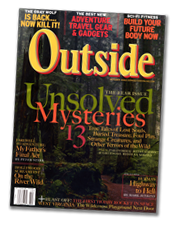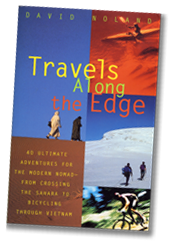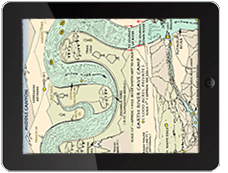Super User
Trip Highlights
Gorgeous drive, with native towns, from Cuzco to Yavero Canyon
Over 100 class 3 - 4+ rapids
Giant otters, Macaws, Toucans
Numerous class 2-3 inflatable kayak rapids
Pongo De Mainique sacred waterfall canyon with over 2 dozen tributary
waterfalls falling as much as 100 feet grom cliffs into the river.
Native village along river that has little contact with outside world
Machu Picchu (directly on the way home from the river take out)
Brief Overview
Cost: (excluding air) $4,750
Total Trip Days: 11 (Thurs. - Sun.) U.S. to U.S.
Expedition days (with Earth River): 9 (Friday. - Sun.)
Season: June & July
Meeting place: Cuzco, Peru
Accomodations: Hotels (3 nights), Camping (6 nights)
Activity level: Moderate/active
Suitable ages: 10 - 78
Percent expedition rafting & inflatable kayaking: 75%
Percent other activities (hiking, Macchu Picchu, Native village): 25%
Multi-sport activities: Rafting (class 4), beginner whitewater inflatable kayaking, hiking
Day by Day
YAVERO ITINERARY
(Click on "VIEWS" to see photos)
Fly from the U.S. to Lima.
This morning we take an early flight (on your own) to Cuzco. We arrive in Cuzco and are met by the Earth River guide and begin the drive to the river. We drive a few hours through beautiful mountain scenery, past Inca settlements and along roaring rivers to the wonderful town of Lares where we stop for lunch. Much of the population in Lares dresses in brightly colored native clothing and the town has a festival feel to it. It also produces woven goods that are sold to tourists throughout Peru. In the afternoon we drive two and a half hours to the town of Quebrada Honda where we either camp or stay in a primitive hotel.
This morning we switch from the bus to four wheel drive vehicles. Cresting the top of the Yavero Canyon we get our first glimpse of the thin green and white ribbon of water 8,000 feet below. Beyond the lush Yavero Canyon, with densely foliated mountains unfold as far as the eye can see as they penetrate into Manu National Park. On no more than a windy, barely one lane cart trail, we descend another 6,500 feet down to the put in on the river where we have lunch. Just below our starting point, a trail crosses a narrow wooden suspension bridge over a dramatic gorge It is believed that the Inca used this trail to escape the Spanish at Machu Picchu and access the Lost City of Gold. After a safety talk, we board the rafts and continue down river running a series of moderately challenging class 3 - 4 rapids.
For the next five days we will paddle nearly 100 thrilling class 3 & 4 rapids through a gorgeous 7,000 foot deep canyon with multiple tributary waterfalls Macaws, monkeys, Giant Otters and countless birds and butterflies. Spring fed seeps adorn moss covered walls. The whitewater is similar in difficulty to the Pacuare in Costa Rica only there are many more rapids. The Yavero’s most impressive rapid, Tobogan, is one of the longest commercially run class IV rapids anywhere . Here the converge and the water surges through a series of crashing waves and sweeping bends for over two kilometers. When the rapids change from class 4 to 3 we will switch from rafts to inflatable kayaks and after a kayak lesson, paddle the swimming pool temperature water through some of the best class 2 -3 beginner kayaking in the world. From the boats we will see giant otters playing in the eddies and multi-colored Macaws soaring through the old growth jungle canopy that overhangs the river. The remote canyon opens up to beautiful camping cut into the jungle engulfed in giant old growth trees The canyon’s eastern boundary is the four million acre Manu National Park. With over 15,000 different flowering plants, 1,000 species of birds, 200 different mammals including 13 different kinds of primates and hundreds of butterflies species, the Manu Biosphere Reserve is considered to be the most diverse region of the Amazon Rain Forest. There will also be the opportunity to visit with the Machiguenga Indigenous community that lives along the river and see first hand how they carve massive trees into dugout canoes in order to transport their crops down river. On day 8 (Our 6th on the river), we raft and kayak the Yavero’s final class 3 rapids and reach the confluence with the the much larger Urubamba. After running five exhilarating class 3+rapids on the Urubamba, with waves as high as 10 feet, we camp on a beautiful beach just upstream for the fabled pong Manique sacred waterfall canyon.
Early this morning, we board the rafts and kayaks and within minutes canyon walls close, and rise hundreds of feet above us as we enter the mysterious and breath takingly beautiful Pongo Mainique Canyon. This 3 kilometer, slot divides the upland cloud forest with the Amazon Jungle. Here the mighty Urubamba takes a final plunge through one last mountain range before entering the flat Amazon basin. This canyon is an important spiritual place for the Machiguenga native people who believe that the souls of their dead reside in the Pongo. In 2001 the Wildlife Conservation Society did a survey of the Pongo Manique and the immediate area around it and said, “The lowland rain forests and mid-mountain cloud forests within a radius of five miles of the Pongo Mainique possibly comprise the single most biologically diverse site on the face of the earth. “ Beyond its cultural and biological significance, the Pongo Mainique is one of the most enchanted places in South America Upon entering the Pongo, we paddle past smooth, water scalloped walls, covered in iridescent, emerald moss with delicate seeps of water collecting into dozens of tiny waterfalls. Around the bend, the symphony of water grows as dozens of impressive waterfalls cascade into the river from as high as 100 feet in heart of the Pongo, over a dozen significant waterfalls can be viewed at once. The chorus of water grows deafening as we run an exciting class 4 rapid framed within this cathedral of falling water. Then suddenly we round a bend and the canyon walls give way to the open plane of the Amazon basin. We pull over at a trailhead and take a wonderful 1.5 hour hike to the top of the canyon where we are afforded a spectacular view of the Pongo Manique and beyond to where the green carpet of the Amazon spreads out as far as the eye can see. After the hike, we are met by a large, motorized wooden dugout canoe that transports us 2 hours back up river to the road to the road at the town of Ivochote where we baord the bus for a two hour drive to the jungle town of Kiteni where we spend the night at a promitive hotel.
This morning we drive three and a half hours to the jungle city of Quillabamba where we have lunch. In the afternoon, we over a high mountain pass with dramatic views of the snow-capped Andes to a trailhead at Hydro-Electrica. From here we walk two spectacular miles along the Urubamba River with soaring cliffs rising two thousand feet over us. We reach the town of Aguas Calientes in the middle of the afternoon and hop on the next bus leaving for Machu Picchu. Surrounded by formidable peaks this ancient mountain-top Inca City stands sentinel over the Urubamba Valley 2,000 feet below. This is an extraordinary time to visit this wonder of the world because the crowds have left. Dominating the site are massive stone walls, buildings and courtyards interconnected by stone steps and access doors. Some of the carved stone blocks that make up the walls weigh 150,000 pounds and are 18 feet high. How this Herculean union of stones was assembled without the use of cement is a mystery. Instead of moving with a throngs of tourists, we are able to discover this architectural masterpiece of man and nature in relative solitude. It is even possible to take sweeping photographs and video of the complex without anyone else in them. We watch the sun set over the imposing mountains and take the bus back down to Aquas Calientes where we baord the narrow gauge train for the two hour ride to the town of Ollantaytambo in the Sacred Vaslley where we check into a hotel dinner and spend the night at a hotel. That evening we have our farewell dinner.
This morning we drive 1 hour to the Cuzco airport and board our flights to Lima and then on to the United States.
Getting There
Fly Thursday evening from U.S. to Lima. Arrive in Lima the following morning and transfer to flight to Cuzco.
NOTE: Cuzco (11,000 feet) is at a very high altitude and it may be difficult to sleep there. If arrive for the trip early, it might be prudent to transfer to the Sacred Valley where the elevation is 9,500 feet.
Yavero, Perú
Only a handful of people have made this extraordinarily diverse journey. It begins in an area that once led to the Lost Incan City of Gold and ends at soaring mountain-top Inca ruins of Machu Picchu. The river takes you from the white crown of the Andes to the raucous, green symphony of the Amazon Jungle. The exotic sights and sounds along the river are astounding: palm tree-size ferns, massive cacti, giant otters, finger-size monkeys, blizzards of butterflies, and rainbow-colored Macaws.
This recently discovered whitewater gem has dozens of class 3 and 4 rapids, for paddle rafting and inflatable kayaking. Two of South America’s grandest marvels, the Pongo Mainique Canyon and Machu Picchu, are part of the itinerary. In terms of biological diversity, native culture and history, weather, scenery and whitewater, this Peruvian journey stands alone in the world of river-based adventure travel. It is also rare to find a river with few bugs, swimming pool temperature water, days in the low eighties and nights in the sixties.
Magpie, Quebec
In terms of dramatic scenery, untouhed wilderness, spectacular camps and numerous class 4 - 4+ rapids, the Magpie is without question one of the top whitewater rafting destinations in the world and in the top two or three in North America. Earth River pioneered rafting on this now classic trip completing the first rafting expedition in 1988.
"It is the unbroken wilderness that makes
the Magpie a superior experience
to the Middle Fork of the Salmon"
- National Geographic Adventure
Outside Kids
 "Save the Fu"
"Save the Fu"
By Barclay Satterfield
We all put a drop of water on the back of our necks, for luck. Beth, one of the river guides, shouted “Remen a delante!” (Spanish for “paddle forward”), and we launched our raft into the rapids of the wild and phosphorescent green waters of Chile's Futaleufu (also called the Fu).
I had traveled from Smyrna, Delaware, last spring to spend seven days with five classmates hiking, rock climbing, riding horses, and, of course, white-water rafting, all before the spectacular backdrop of the Andean rainforest. Accompanying us once we arrived were Suj ey and Katia, two girls from the nearby town of Futaleufu, Chile. It was one of the most incredible trips of my life. And certainly the most disturbing.
New York Times
In Remote Chile, a Paradise Carved by White Water

The white-water outfitter Eric Hertz spent a lifetime searching for the perfect river. In 1990, he finally found it, in Patagonia. Intrepid kayakers who had ventured into southern Chile the previous year said that the Futaleufú River could not be rafted. But Hertz figured out how to safely navigate what today is the most intensive stretch of commercially rafted white-water rapids in the world. The company began protecting the shoreline and have turned the Fu into an outstanding adventure destination for rafters and kayakers.
Boston Globe
"On the Wild Side of Chile"
By Peter May
FUTALEUFU, Chile—So, my neighbor said, you really should come along. It's summer down there in February and this river is supposed to be beautiful.Chile? Yeah, right. That'll happen. Rafting? On a real river whose name I can't pronounce which has sharp rocks and big rapids? I don't think so. But, of course, it did happen. I'm here to report that I survived my first white-water rafting adventure—thanks to my swimming ability. I'm also here to report that if I can do it, just about anyone else can, and that I'd do it again. My neighbor had predicted this reaction. You'll come back a convert, he assured me. You'll be looking for the next big river now that you're a Class 5 guy.
Travels along the edge
 "Rafting the Futaleufu"
"Rafting the Futaleufu"
By David Noland (book chapter)
One day in 1989, as Eric Hertz's rented Toyota van bucked along a dirt road through the remote mountains of southern Chile, he looked down from a bridge and was what appeared to be a narrow tongue of the Caribbean Sea, a ribbon on bright aquamarine blue foaming with whitecaps.
Hertz, the owner of a small whitewater rafting company called Earth River Expeditions, had paddled down wild and scenic rivers all over the world, but he'd never seen anything like this. He stopped the van, walked over to the railing, and stared down at the rushing water. “I knew in an instant that this was the most beautiful river I'd ever seen.” Hertz recalls. “No other river has ever affected me like that. Not the Colorado, not even the Bio Bio. It was like God had designed the perfect whitewater river and laid it at my feet.”
Copyright © 2020 Earth River Expeditions


